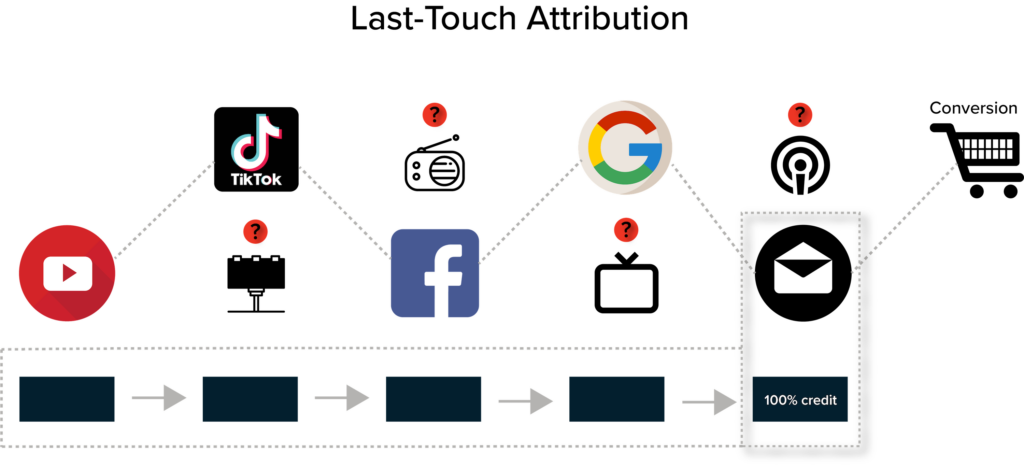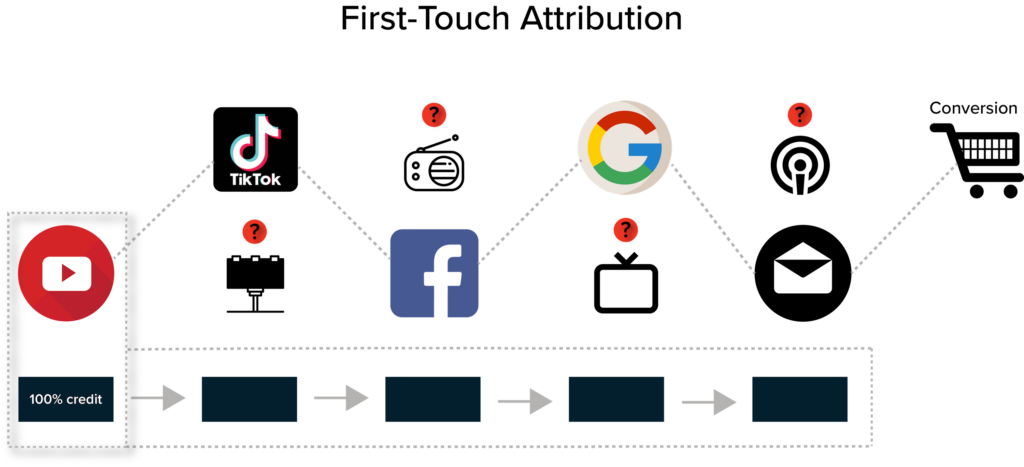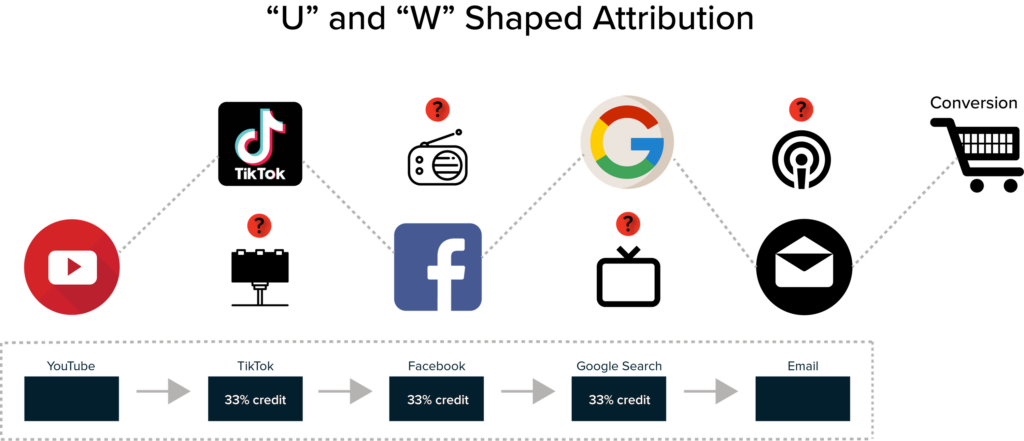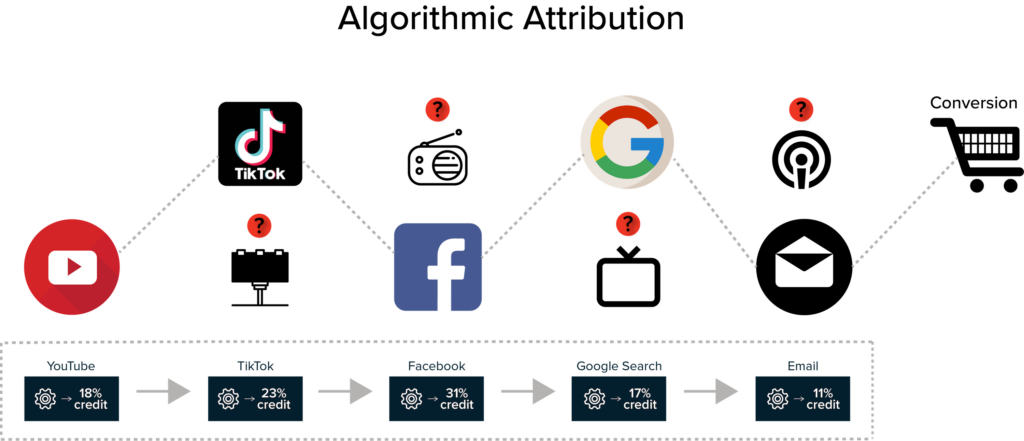Best eCommerce Attribution Models
12/20/2023
In the realm of online retail, attribution models serve as invaluable tools for unraveling the complexities of consumer behavior. As we delve into the intricacies of eCommerce attribution models in this blog post, we will shine a spotlight on why ecommerce attribution is important, revealing how businesses can leverage these models to optimize marketing strategies and boost conversions, while also navigating their pitfalls and weaknesses. Understanding the limitations of attribution models is crucial for brands seeking a comprehensive view of their marketing landscape. Let’s dive in!

Why is Attribution for eCommerce Important?
Attribution in eCommerce is crucial because it provides valuable insights into the customer journey and helps businesses understand the various touchpoints that contribute to a conversion. By accurately attributing sales or conversions to specific marketing channels, campaigns, or interactions, brands can optimize their marketing strategies and allocate resources effectively. Attribution aims to help eCommerce businesses identify the most impactful marketing channels, measure the ROI of their campaigns, and make data-driven decisions to enhance overall performance. Without proper measurement, it becomes challenging to determine which marketing efforts are driving success and which ones need adjustment. By gaining a comprehensive understanding of customer behavior and the factors influencing their purchasing decisions, eCommerce brands can tailor their marketing efforts to target the right audience at the right time, ultimately improving conversion rates and maximizing revenue.
Common eCommerce Attribution Models
Different attribution models offer different perspectives on how credit should be distributed throughout the customer journey. Here are some of the most common attribution models in eCommerce:
Last Click (or Last-Touch) Attribution

In this model, all credit for a conversion is given to the last touchpoint or interaction before the purchase.
The pros of last click attribution:
- It is simple and easy to understand
- It doesn’t require any PII
- It is easily measured for free and doesn’t require complex software
The cons of last click attribution:
- It almost always over-values lower funnel ads such as paid search
- It almost always under-values all other media, especially media with low-click rates such as video, display, non-brand search, as well as any media that doesn’t have direct engagement (e.g. clicks)
- It makes a poor assumption that only clicks drive purchases, and that other media without clicks does not
- It can lead to extremely poor marketing investment decisions that will harm the eCommerce brand in the long run
First Click (or First-Touch) Attribution

This model attributes the entire conversion value to the first touchpoint or interaction in the customer journey.
The pros of first click attribution:
- It gives more credit to earlier funnel media, and avoids giving all of the credit to lower funnel media
- It doesn’t require any PII
- It is easily measured for free and doesn’t require complex software
The cons of first click attribution:
- It almost always over-values upper funnel ads that have been seen within short windows of time (1-2 weeks before conversion)
- Cookie windows and cookie expiration dramatically shorten the measurement window (and potential effects) of longer-term awareness-building ads
- It relies on clicks thereby ignoring the awareness-building effects of ad impressions
- It can lead to extremely poor marketing investment decisions that will harm the eCommerce brand in the long run
Fractional (or Rules-Based) Attribution

This model attempts to assign weights, factors or “rules” to give credit to different points in the funnel.
The pros of fractional attribution:
- Tries to address the weaknesses of last click attribution by giving more credit to ads that don’t usually get credit
- It can lead to more investment in upper-funnel media
- It doesn’t require any PII
- It is easily measured for free and doesn’t require complex software
The cons of fractional attribution:
- Most of the weights are arbitrary and are not rooted in any data or evidence
- The weights are too simplistic and assign the same credit for channels that likely have significant differences among specific campaigns or ads within them
- It is usually highly inaccurate and will lead to extremely poor marketing investment decisions that will harm the eCommerce brand in the long run
“U” and “W” Shaped Attribution

This model also attempts to assign weights, factors, or “rules” to give credit to different points in the funnel, usually by assigning more credit to the first and last ads in the sequence. In the “W”, more credit is given to the “mid-funnel” with the assumption that it contributes more too.
The pros of “U” and “W” shaped attribution:
- Tries to address the weaknesses of last click attribution but giving more credit to ads that don’t usually get credit
- Can lead to more investment in upper-funnel media by assuming that the first ad “seen” introduces the brand to the customer
- They don’t require any PII
- They are easily measured for free and don’t require complex software
The cons of “U” and “W” shaped attribution:
- Most of the weights are arbitrary and are not rooted in any data or evidence
- The weights are too simplistic and assign the same credit for channels that are likely to have significant differences among specific campaigns or ads within them
- First click ads are usually cut off from consideration due to cookie expiration, especially as browser, ad platforms and mobile operating systems have moved to reduce cookies and cookie lifetimes
- They are highly inaccurate and will lead to extremely poor marketing investment decisions in the that will harm the eCommerce brand in the long run
Algorithmic Attribution

This model is a more complex approach that sometimes uses predictive models and correlations to calculate across sequences, typically requiring an expensive 3rd party solution to provide marketing measurement.
The pros of algorithmic attribution:
- Tries to address the weaknesses of more simplistic rules-based methods
- A model or algorithm assigns credit as opposed to simplistic methods
- Attempts to compare ad sequences from customers who have seen the ads versus those who haven’t
The cons of algorithmic attribution:
- Require the use of PII and the sharing of customer data with external vendors and systems
- Suffer accuracy problems with poor customer match rates and identity mis-matches
- Require expensive software
- Ignore traditional media (unless you buy an even more expensive Marketing Mix Modeling solution add-on)
- Ignore non-marketing factors that drive conversions like promotions & discounts, the economy, weather, etc.
- Suffering major gaps due to Apple’s iOS 14.5, the upcoming death of Google’s cookie, and other consumer privacy data moves in the market
- Not future-proof due to the wave of privacy regulations and other tech industry changes
Custom Attribution Models
Some brands opt to create their own attribution models tailored to their specific needs and objectives, which can be useful for those with unique customer journeys or specific marketing strategies that standard models may not capture accurately. However, this is extremely difficult to execute because it is time-consuming, resource-draining, and requires analytic expert(s).
How to Choose an Attribution Model for Your eCommerce Site

Choosing the right attribution model for your eCommerce site involves considering various factors related to your business, customer journey, and marketing objectives. Here are steps to help you make an informed decision:
1. Understand Your Customer Journey
Analyze your customer journey to identify key touchpoints and interactions. Consider the typical stages a customer goes through before making a purchase. Understanding this journey is essential for choosing an attribution model that aligns with your customer behavior.
2. Define Your Goals
Clearly outline your business goals and what you want to achieve with your attribution model. Whether it’s increasing brand awareness, driving first-time purchases, or encouraging repeat business, your goals will influence the type of attribution model that makes the most sense for your objectives.
3. Consider Your Product and Sales Cycle
The nature of your products and the length of your sales cycle can impact the relevance of different attribution models. For products with a longer sales cycle, models that give credit to multiple touchpoints over time (e.g., time decay or position-based) may be more appropriate.
4. Review Existing Data
Examine historical data and performance metrics of your marketing channels under different attribution models. Consider how each model impacts the perceived effectiveness of your channels. This analysis can provide insights into which model aligns better with your actual customer behavior.
5. Test Multiple Models
Conduct A/B testing or use split testing to compare the performance of different attribution models. Implementing multiple models simultaneously can help you assess their impact on decision-making and understand which one provides the most actionable insights.
6. Be Adaptable
Consumer behavior and marketing landscapes change. Regularly reassess your chosen attribution model to ensure it remains relevant and aligned with your evolving business goals and strategies.
7. Utilize Technology and Analytics
Leverage analytics tools and technologies that support advanced attribution modeling. Some platforms offer built-in capabilities for experimenting with different models and visualizing the impact on conversion paths.
8. Seek Professional Advice
If you find the decision challenging, consider consulting with digital marketing experts or data analytics professionals who specialize in attribution modeling. Their expertise can provide valuable insights and guidance tailored to your specific needs.
Remember that the “best” attribution model is context-dependent and can vary from one eCommerce brand to another. It’s crucial to choose a model that fits your unique circumstances and supports your overarching business goals. Regularly reassess and refine your approach based on changing market dynamics and business requirements.
Weaknesses of eCommerce Attribution

While attribution models in eCommerce may offer valuable insights into the customer journey and the effectiveness of marketing efforts, they also have some inherent weaknesses and limitations. It is important to be aware of these challenges to make informed decisions and interpretations. Here are some common weaknesses of eCommerce attribution:
Simplification of Complex Customer Journeys
Attribution models often simplify the complexity of customer journeys by assigning credit to specific touchpoints. In reality, customer decision-making can be intricate, involving multiple channels and interactions. Attribution models may struggle to capture the full complexity of these journeys.
Overemphasis on Last Click Attribution
Last click attribution, while simple, tends to give disproportionate credit to the final touchpoint before conversion. This may overlook the contribution of earlier interactions that played a crucial role in influencing the customer’s decision.
Difficulty in Quantifying Brand Awareness
Metrics related to brand awareness, which may influence customer decisions indirectly over time, are challenging to quantify accurately using traditional attribution models. Building brand equity may not be adequately reflected in models that emphasize direct response channels.
Fixed Attribution Rules
Most attribution models operate on fixed rules, distributing credit based on predetermined algorithms. These fixed rules may not capture the dynamic and evolving nature of customer behavior, leading to inaccuracies in assigning credit.
Ignoring Cross-Device Behavior
Many customers use multiple devices during their journey, such as switching from mobile to desktop. Attribution models may struggle to track and consolidate these cross-device interactions, resulting in incomplete data.
External Factors and Market Dynamics
Attribution models often don’t account for external factors that can influence customer behavior, such as economic conditions, seasonal trends, or industry developments. These factors can significantly impact the effectiveness of marketing efforts.
Data Quality and Accuracy
The accuracy of attribution models depends on the quality of the data they rely on. Issues such as data discrepancies, incomplete data sets, or inaccurate tracking can compromise the reliability of attribution insights.
Limited Insight into Assisted Conversions
Some attribution models may not provide sufficient insight into assisted conversions, where multiple touchpoints contribute to a sale. This can make it challenging to understand the holistic impact of various marketing channels.
Subjectivity in Custom Models
Custom attribution models, while flexible, can be subjective and dependent on the biases of the model creator. Different stakeholders within an organization may have varying opinions on how credit should be assigned, leading to disagreements.
Best eCommerce Attribution Software
The bottom line is that any attribution software solution or model that relies on PII and/or consumer tracking is currently facing major issues with data loss and regulatory risks, and getting worse over time. These privacy related issues make traditional attribution using PII a bad fit for any brand, eCommerce-centric or not.
Wondering if attribution models just might not be the best option for your brand? If that is the case, consider going beyond traditional eCommerce attribution models and into the world of Marketing Mix Modeling.

Moving away from touch-based attribution and utilizing Marketing Mix Modeling (MMM) in eCommerce presents several advantages:
- A holistic perspective: MMM transcends the confines of digital touchpoints to encompass both online and offline channels. By considering a comprehensive set of factors, including macroeconomic variables and external influences, MMM provides a more nuanced understanding of the intricate interplay between marketing efforts and business outcomes.
- Flexibility: The model’s flexibility in variable selection allows brands to tailor analyses to their specific industry dynamics and product offerings, fostering a customized and insightful approach.
- Statistical accuracy: MMM’s statistical rigor and ability to establish causality contribute to robust decision-making, offering a clearer comprehension of how marketing activities impact long-term brand equity and market share.
- 100% privacy-safe: Unlike touch-based attribution models, Marketing Mix Modeling doesn’t rely on any consumer tracking and/or PII, so your brand is always in compliance with all current and future privacy regulations.
- And, as eCommerce increasingly embraces omnichannel strategies, the capacity of MMM to attribute the impact of marketing to both online and offline sales positions it as a powerful tool for strategic planning, resource allocation, and achieving a comprehensive view of the customer journey.
Interested in learning more about how a Marketing Mix Modeling solution like OptiMine could help your eCommerce brand measure their marketing? Contact us today!

